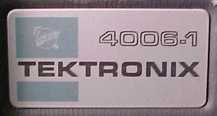



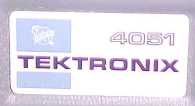

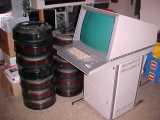
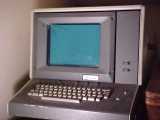
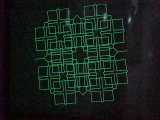
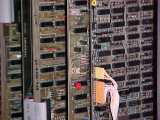

Vector graphics terminals are computer graphics displays that draw lines instead of bitmapped images. They were the standard computer graphics display in the 1960s and 1970s. They were rendered obsolete by the emergence of decent bitmapped workstations in the early 80s - especially machines from Apollo, Sun, and SGI.
A vector graphics display is basicly a computer controlled oscilliscope. It draws lines and curves by moving the electron beam exactly where the line is supposed to go, instead of breaking it into dots and scanning the electron beam back and forth, like a television set does. That is, to draw a line from point a to point b, it moves the electron beam to point a, turns it on, moves it directly to point b, and turns it off.
All modern computer displays are raster displays, which means that all objects to be displayed are rendered into a bitmap, and the electron beam scans each row of the display in sequence, turning on and off to display each pixel.
Prior to the 1980s, high-resolution raster displays were not feasable because memory was too expensive. If your main computer only had 64 kilobytes of memory, you certainly couldn't afford to throw a megabyte away on display memory!
The other advantage of vector graphics is that lines and curves look much cleaner than their rasterized equivalent. They suffer much less from "aliasing", or "stepping" which is a result of breaking a diagonal line up into dots, resulting in something that looks like a staircase in some cases. Because the electron beam actually moves diagonally from the beginning of the line to the end, the resulting line has very straight, clean, diagonal edges.
Tektronics invented the storage tube vector graphics terminal, and dominated the market for the approximately 15 years that the market existed.
Storage tube vector graphics terminals differ from refreshing vector graphics terminals in that the display stored whatever was drawn on it, and did not have to be refreshed many times a second in order to maintain a continuous image. One problem with refreshing vector displays is that they must continuously scan through the list of objects they are displaying, redrawing them as fast as possible, to maintain a visible image. Unlike a raster device where the path the electron beam follows is always the same, and always takes the same amount of time to follow, the path the electron beam follows on a vector display takes longer and longer as more objects are drawn. Therefore once a certain number of lines are being displayed, the display begins to flicker. Display list memory also limited the number of line segments that could be viewed simultaneously.
To get around these problems, the storage tube was used. In a storage tube, there are actually two electron guns. One draws lines on the screen, the other bathes the entire display in electrons at a lower intesity. This second beam keeps any phospher that has been activated continuously illuminated. Thus when a line has been drawn with the first beam, the second beam keeps it lit. Therefore the terminal only has to draw a line once, and it remains on the screen. There is no flicker, and no problem with having lots and lots of objects on the screen at once.
The trade-off is that it cannot erase anything except by clearing the entire screen. Therefore you cannot have motion or any sort of animation on the screen. Later displays got around this by using a lower-intensity mode for drawing which was not intense enough for the phospher to remain lit by the second beam. When it wanted to draw a permenant line, it still could, by increasing the intensity of the drawing beam for that one object. Later tektronics terminals did this. The early models did not, except for the special cases of the cursor, and displaying cross-hairs to let the user select a point.
Most of the Tektronics terminals have a special mode that allows the user to pick a point on the screen and transmit the (x,y) coordinates of that point to the host system, without burdening the host system with maintaining the display during this interactive process. Once in this mode, the terminal will display cross-hairs on the screen, and allow the user to move these around by using the XY dials to the right of the keyboard. Once the user has positioned the crosshairs exactly where they are desired, a key is pressed, and the coordinates of the crosshairs, plus the pressed key, are transmitted to the host.
I currently have in my collection:
Type 611 Storage Display Unit